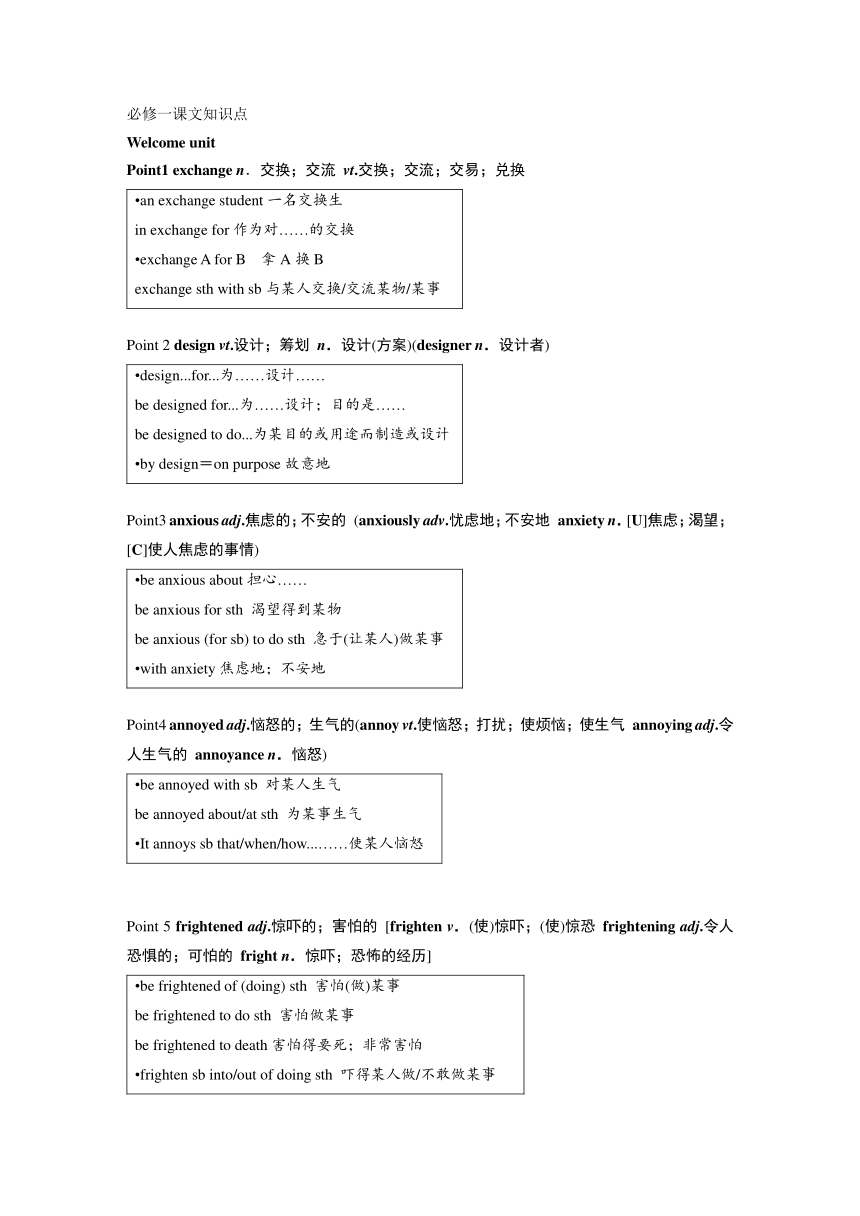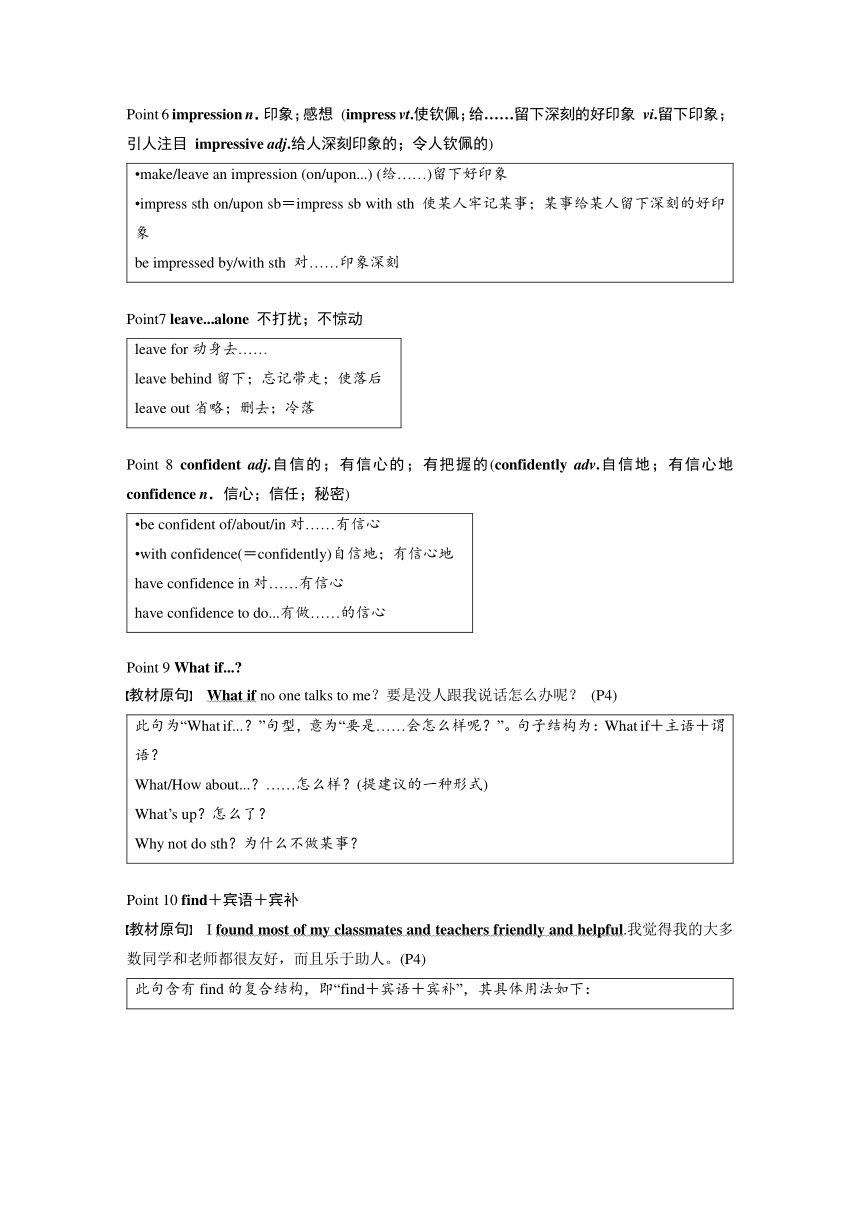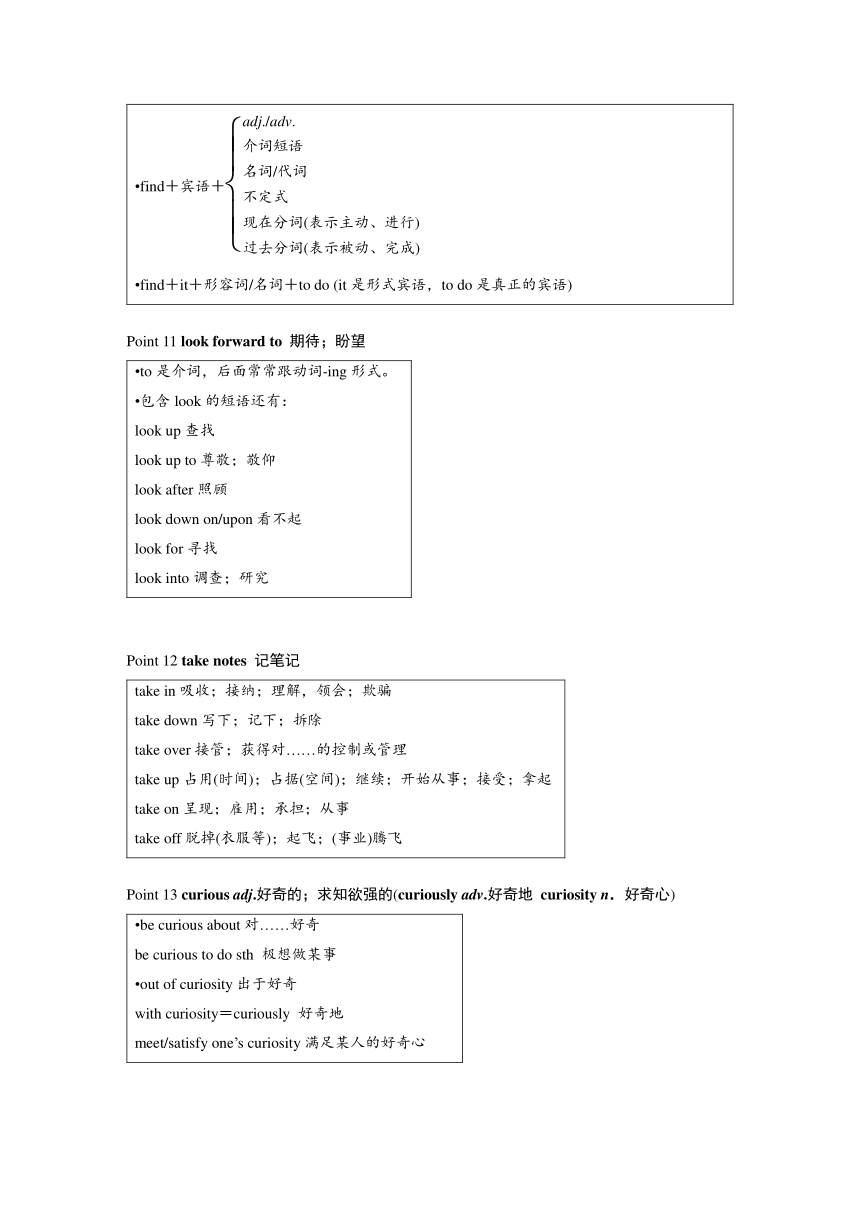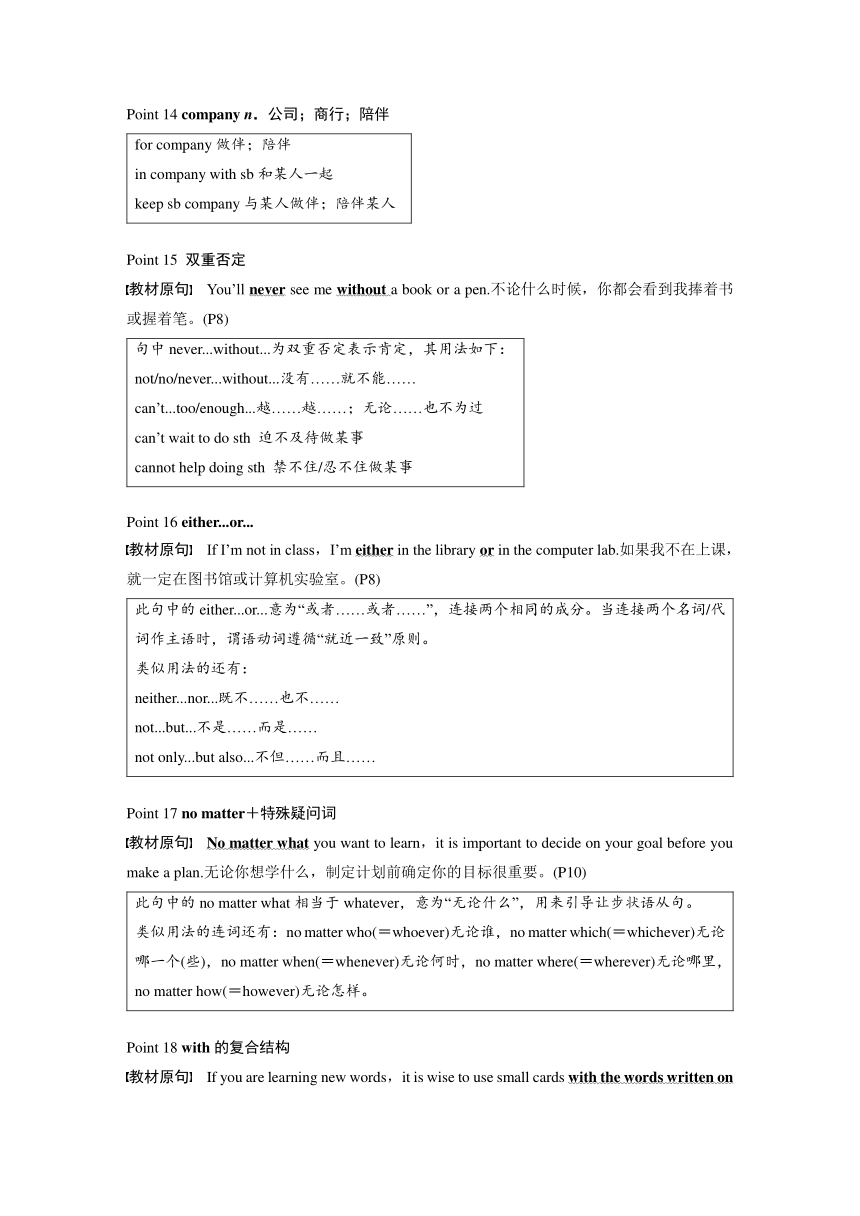 資源簡介
資源簡介
必修一課文知識點
Welcome unit
Point1 exchange n.交換;交流 vt.交換;交流;交易;兌換
an exchange student一名交換生 in exchange for作為對……的交換 exchange A for B 拿A換B exchange sth with sb與某人交換/交流某物/某事
Point 2 design vt.設計;籌劃 n.設計(方案)(designer n.設計者)
design...for...為……設計…… be designed for...為……設計;目的是…… be designed to do...為某目的或用途而制造或設計 by design=on purpose故意地
Point3 anxious adj.焦慮的;不安的 (anxiously adv.憂慮地;不安地 anxiety n.[U]焦慮;渴望;[C]使人焦慮的事情)
be anxious about擔心…… be anxious for sth 渴望得到某物 be anxious (for sb) to do sth 急于(讓某人)做某事 with anxiety焦慮地;不安地
Point4 annoyed adj.惱怒的;生氣的(annoy vt.使惱怒;打擾;使煩惱;使生氣 annoying adj.令人生氣的 annoyance n.惱怒)
be annoyed with sb 對某人生氣 be annoyed about/at sth 為某事生氣 It annoys sb that/when/how...……使某人惱怒
Point 5 frightened adj.驚嚇的;害怕的 [frighten v.(使)驚嚇;(使)驚恐 frightening adj.令人恐懼的;可怕的 fright n.驚嚇;恐怖的經歷]
be frightened of (doing) sth 害怕(做)某事 be frightened to do sth 害怕做某事 be frightened to death害怕得要死;非常害怕 frighten sb into/out of doing sth 嚇得某人做/不敢做某事
Point 6 impression n.印象;感想 (impress vt.使欽佩;給……留下深刻的好印象 vi.留下印象;引人注目 impressive adj.給人深刻印象的;令人欽佩的)
make/leave an impression (on/upon...) (給……)留下好印象 impress sth on/upon sb=impress sb with sth 使某人牢記某事;某事給某人留下深刻的好印象 be impressed by/with sth 對……印象深刻
Point7 leave...alone 不打擾;不驚動
leave for動身去…… leave behind留下;忘記帶走;使落后 leave out省略;刪去;冷落
Point 8 confident adj.自信的;有信心的;有把握的(confidently adv.自信地;有信心地 confidence n.信心;信任;秘密)
be confident of/about/in對……有信心 with confidence(=confidently)自信地;有信心地 have confidence in對……有信心 have confidence to do...有做……的信心
Point 9 What if...
教材原句 What if no one talks to me?要是沒人跟我說話怎么辦呢? (P4)
此句為“What if...?”句型,意為“要是……會怎么樣呢?”。句子結構為:What if+主語+謂語? What/How about...?……怎么樣?(提建議的一種形式) What’s up?怎么了? Why not do sth?為什么不做某事?
Point 10 find+賓語+賓補
教材原句 I found most of my classmates and teachers friendly and helpful.我覺得我的大多數同學和老師都很友好,而且樂于助人。(P4)
此句含有find的復合結構,即“find+賓語+賓補”,其具體用法如下: find+賓語+ find+it+形容詞/名詞+to do (it是形式賓語,to do是真正的賓語)
Point 11 look forward to 期待;盼望
to是介詞,后面常常跟動詞-ing形式。 包含look的短語還有: look up查找 look up to尊敬;敬仰 look after照顧 look down on/upon看不起 look for尋找 look into調查;研究
Point 12 take notes 記筆記
take in吸收;接納;理解,領會;欺騙 take down寫下;記下;拆除 take over接管;獲得對……的控制或管理 take up占用(時間);占據(空間);繼續;開始從事;接受;拿起 take on呈現;雇用;承擔;從事 take off脫掉(衣服等);起飛;(事業)騰飛
Point 13 curious adj.好奇的;求知欲強的(curiously adv.好奇地 curiosity n.好奇心)
be curious about對……好奇 be curious to do sth 極想做某事 out of curiosity出于好奇 with curiosity=curiously 好奇地 meet/satisfy one’s curiosity滿足某人的好奇心
Point 14 company n.公司;商行;陪伴
for company做伴;陪伴 in company with sb和某人一起 keep sb company與某人做伴;陪伴某人
Point 15 雙重否定
教材原句 You’ll never see me without a book or a pen.不論什么時候,你都會看到我捧著書或握著筆。(P8)
句中never...without...為雙重否定表示肯定,其用法如下: not/no/never...without...沒有……就不能…… can’t...too/enough...越……越……;無論……也不為過 can’t wait to do sth 迫不及待做某事 cannot help doing sth 禁不住/忍不住做某事
Point 16 either...or...
教材原句 If I’m not in class,I’m either in the library or in the computer lab.如果我不在上課,就一定在圖書館或計算機實驗室。(P8)
此句中的either...or...意為“或者……或者……”,連接兩個相同的成分。當連接兩個名詞/代詞作主語時,謂語動詞遵循“就近一致”原則。 類似用法的還有: neither...nor...既不……也不…… not...but...不是……而是…… not only...but also...不但……而且……
Point 17 no matter+特殊疑問詞
教材原句 No matter what you want to learn,it is important to decide on your goal before you make a plan.無論你想學什么,制定計劃前確定你的目標很重要。(P10)
此句中的no matter what相當于whatever,意為“無論什么”,用來引導讓步狀語從句。 類似用法的連詞還有:no matter who(=whoever)無論誰,no matter which(=whichever)無論哪一個(些),no matter when(=whenever)無論何時,no matter where(=wherever)無論哪里,no matter how(=however)無論怎樣。
Point 18 with的復合結構
教材原句 If you are learning new words,it is wise to use small cards with the words written on them. 如果你在學新單詞,使用寫有這些單詞的小卡片是明智的。 (P10)
句中的with the words written on them 是with的復合結構,即“with+賓語+賓補”,其用法如下: with+賓語+done(表示被動或已經完成的動作) with+賓語+doing(表示主動或正在進行的動作) with+賓語+to do(表示將來的動作) with+賓語+adj./adv./介詞短語
Unit 1
Point1 prefer vt.寧愿(要);較喜歡(preference n.偏愛;優先;偏愛的事物/人)
prefer to do/doing sth更喜歡做某事 prefer sb to do...寧愿某人做…… prefer (doing) A to (doing) B寧愿(做)A而不愿(做)B prefer to do A rather than do B寧愿做A而不愿做B have a preference for偏愛……
Point 2 content n.內容;[pl.]目錄;(書、講話、節目等的)主題;滿意 vt.滿足,知足 adj.滿意的;滿足的
with content滿意地 content oneself with滿足于 feel/be content with...對……滿足/滿意 be content to do sth愿意做某事
Point 3 suitable adj.合適的;適用的 (unsuitable adj.不合適的;不適用的 suit vt.適合;使適宜)
be suitable for sb/sth適合于某人/某物 be suitable to do sth適合做某事 suit sb滿足/適合某人;合身 suit one’s needs滿足某人的需求
Point 4 confusing adj.難以理解的;不清楚的;令人困惑的 (confuse vt.使困惑;使糊涂;混淆 confused adj.迷惑的;混亂的;糊涂的 confusion n.混淆,混亂;困惑)
confuse sb/sth and/with sb/sth將……與……混淆 be confused about對……迷惑不解 in confusion困惑地
Point5 recommend vt.推薦;介紹;勸告;建議(recommendation n.建議;推薦)
recommend sb/sth (to sb)(向某人)推薦某人/某物 recommend sb/sth as...推薦某人/某物當…… recommend doing sth建議做某事 recommend sb to do sth建議某人做某事 recommend that...(should) do...建議……做……
Point 6 responsible adj.有責任的;負責的(responsibly adv.負責地;有責任地 responsibility n.責任;義務)
be responsible for對……負責 take responsibility for (doing) sth承擔(做)……的責任 a sense of responsibility責任感 It is sb’s responsibility to do sth.做某事是某人的職責。
Point 7 schedule n.日程安排;工作計劃;時刻表 vt.安排;預定
on schedule準時;按時間表 ahead of schedule提前 behind schedule遲于預定時間 be scheduled for預定;安排 be scheduled to do...預定做……
Point 8 動詞-ing形式作主語
教材原句 Going from junior high school to senior high school is a really big challenge.從初中過渡到高中確實是一項巨大的挑戰。(P14)
此句中的Going from junior high school to senior high school是動詞-ing形式作主語,其用法如下: 單個的動詞-ing形式在句中作主語,謂語動詞用單數。 下列句型中it作形式主語,動詞-ing形式是真正的主語: It’s no use/no good doing sth.做某事沒有用處/好處。 It’s useful/useless doing sth.做某事有用處/沒有用處。 It’s a waste of time doing sth.做某事是浪費時間。
Point 9 so that引導目的狀語從句
教材原句 I’ll find a way to improve on my own so that I can make the team next year.我會找到一個讓自己提高球技的方法,這樣明年我就能加入球隊了。(P14)
句中so that引導目的狀語從句,從句中含有情態動詞can。 so that引導目的狀語從句,意為“以便,為了”,可用in order that 替換,從句中常有may,can,could等情態動詞。 表示目的還可以用“so as to/in order to+動詞原形”。 so that也可引導結果狀語從句,意為“因此,所以”,通常不與情態動詞連用,從句前可用逗號與主句隔開。 注意:引導目的狀語從句時,so that一般不用于句首,而in order that可用于句首。
Point10 it作形式主語
教材原句 I’m a bit worried about keeping up with the other students in my advanced course,and it’ll be quite difficult to get used to all the homework.我有點擔心在高級課程上無法跟上其他同學,而且要適應所有的作業也不容易。(P14)
此句中的it作形式主語,to get used to all the homework是不定式短語作真正的主語。其用法如下: It+is/was+形容詞/名詞+to do sth,這一句型中不定式作真正的主語。 It is said/reported/believed/thought that...據說/據報道/據認為……,這個句型中that從句作真正的主語。 It takes sb some time to do sth做某事花費某人一些時間。 注意:不定式作真正的主語時,其前可以加for sb(句中的形容詞描述不定式行為的性質或特點)或of sb(句中的形容詞描述sb的性格、品行)。
Point11 behaviour n.行為;舉止 [behave v.(以某種方式)表現;(使)守規矩;(使)舉止……]
good/bad behaviour良好/惡劣行為 behave oneself舉止規矩有禮;檢點 behave well/badly舉止良好/差 well-behaved adj.表現好的 badly-behaved adj.表現差的 注意:behaviour是不可數名詞,前面不加a。
Point12 attract vt.吸引;引起……的注意(或興趣)(attraction n.吸引;吸引力;名勝;有吸引力的事/人 attractive adj.有吸引力的;有魅力的)
attract one’s attention/eyes吸引某人的注意/目光 attract sb to sth吸引某人關注某事 be attracted to喜愛 a tourist attraction=a place of interest旅游景點
Point13 focus v.集中(注意力、精力等);(使)調節焦距 n.中心;重點;焦點
focus (one’s attention/energy) on/upon集中(注意力/精力)于;聚焦(……)于 focus on全神貫注于;集中于…… the focus of...……的焦點/中心
Point14it作形式賓語
教材原句 But spending too much time online is unhealthy and makes it very difficult to focus on other things in life.然而,花費太多時間上網有損健康,也會讓你們很難把精力放在生活中的其他事情上。(P18)
句中it是形式賓語,不定式短語是真正的賓語,而very difficult是形容詞短語作賓語補足語。可作賓補的還有名詞、代詞、現在分詞、不定式、過去分詞、介詞短語等。 真正賓語的三種形式:動詞不定式(短語),動詞-ing形式(短語)及賓語從句。 可用it作形式賓語的常見動詞有find,consider,make,believe,think,feel等。
Point15 it is because...
教材原句 I guess it’s because they’re adults and can’t understand me.我猜測那是因為他們是成年人,不能理解我。(P19)
此句中because引導的是表語從句,其用法如下: This/That/It is because...這/那是因為…… This/That is why...這/那就是……的原因 The reason why...is that...……的原因是……
Point16 the next time用作連詞
教材原句 So the next time you feel like you do not want to do boring,difficult homework or go to class,think about the children who don’t have the chance to get a good education.因此,下一次你感到不想做枯燥、困難的作業或者上課時,就想想那些沒有機會接受良好教育的孩子們。(P20)
本句中的the next time用作連詞,引導時間狀語從句,意為“下一次……時”,注意時態為“主將從現”。 此外,下列time短語都可用作連詞,引導時間狀語從句:(the) last time(上次做某事的時候),the first time(第一次),every/each time(每一次)。
Unit2
Point1 apply vi.& vt.申請;請求 vt.涂;敷;應用;運用 [application n.申請(書);應用 applicant n.申請人]
apply to do sth 申請做某事 apply (to sb) for sth (向某人)申請某物 apply sth to...把某物應用/涂抹于…… apply to適用于 apply oneself to (doing) sth 致力于/專心于(做)某事
Point2 amazing adj.令人驚奇的;令人驚喜的 (amaze vt.使驚奇 amazed adj.驚奇的;驚喜的 amazement n.驚奇;驚喜)
It is amazing that...令人驚奇的是…… be amazed at/by/that...對……感到驚訝 be amazed to do sth 對做某事感到驚奇 to one’s amazement令某人驚訝的是 in amazement吃驚地;驚訝地
Point3 arrangement n.安排;籌備(arrange vt.& vi.安排;籌備)
make arrangements/an arrangement for為……做安排 arrange sth for sb 為某人安排某事 arrange (for sb) to do sth 安排(某人)做某事
Point4 take control of 控制;接管
bring...under control使……處于控制之下 beyond one’s control某人無法控制 lose control of對……失去控制 in control of控制 out of control失去控制 have control of/over...對……有控制能力
Point5 recognise vt.辨別出;承認;認可(=recognize)(recognition n.承認;認可;認出)
recognise sb/sth 辨認出某人/某物 recognise sb/sth as/to be...承認某人/某物是…… It is recognised that...人們公認…… beyond recognition無法辨認
Point6 contact vt.聯絡;聯系 n.聯系;接觸
contact sb at...通過(郵箱、電話等)聯系某人 keep/stay in contact with與……保持聯系 lose contact with與……失去聯系 make contact with和……取得聯系
Point7 強調句型
教材原句 It is for this reason that Spanish is the main official language of Peru.正因為如此,西班牙語是秘魯的主要官方語言。
本句用It is...that...的強調句型對for this reason進行強調。強調句型的結構:It is/was+被強調部分+that/who+其余部分。 強調句型通常用來強調句子的主語、賓語或狀語。如果強調的是人,可以用who或that,其他情況一律用that。 強調句的一般疑問句和特殊疑問句結構: Is/Was it+被強調部分+that/who+其余部分? 特殊疑問詞+is/was it+that+其余部分? 注意:本強調結構不能用于強調句子的謂語。
Point8 完全倒裝
教材原句 Especially amazing is the Incas’ dry stone method of building.尤其令人稱奇的是印加人的干式石頭搭砌的建造方法。
此句中的Especially amazing放在句首引起完全倒裝,其用法如下: 作表語的分詞短語、形容詞提到be動詞前面時,句子用完全倒裝結構,即“分詞/形容詞+be動詞+主語”結構。 表示地點的介詞短語置于句首,謂語動詞是be,stand,sit,lie等且主語是名詞時,句子用完全倒裝結構。 代詞such置于句首,且在句中作表語時,句子用完全倒裝結構。 out,in,down,up,here,there,now,then,away等表示方位、地點和時間的副詞置于句首,謂語是come,go,rush等且主語是名詞時,句子用完全倒裝結構。
Point9 request n.& vt.要求;請求
at sb’s request=at the request of sb 應某人的請求/要求 request sb to do sth 要求某人做某事 request that sb (should) do sth 要求某人做某事
Point10 view n.視野;景色;看法 vt.把……視為;看
come into view進入視野;看得見 broaden/widen one’s view開闊某人的視野 point of view觀點 in one’s view(=from one’s point of view)在某人看來;依某人的看法 in view of由于;鑒于 view...as...把……看作……
Point11 sight n.景象;視力;視野
lose sight of看不見;忽視 catch sight of看見;發現 in sight看得見,在視線內 out of sight看不見 at first sight乍一看 at the sight of...一看見……
Point12 comment n.評論;議論 vi.& vt.發表意見;評論
make comments/a comment on/about...對……作出評論 no comment無可奉告(常用于回答記者的提問) comment on/upon...對……作出評論
Point13動詞-ing短語作狀語
教材原句 We’re taking the train,leaving the day before the October holiday begins.我們將乘火車,在十月假期的前一天離開。
此句中的leaving the day before the October holiday begins為動詞-ing短語作狀語,表伴隨情況。 動詞-ing形式作狀語,表示主動、進行或自然而然的結果。 動詞-ing形式表示的動作與句子主語是邏輯上的主謂關系。
Unit3
Point1 come along 跟隨;到達;進步;趕快
come about(尤指未經計劃)發生;產生 come across偶然遇到;碰見 come up上來;走近;被提出 come up with提出(計劃、想法);想出 come out出現;出版;結果是 when it comes to (doing) sth當談及/說到(做)某事
Point2 make it 獲得成功;準時到達
make out弄清楚;看出;聽出 make up組成;編造;化妝 make up for彌補 make a difference (to...)(對……)有作用或影響
Point3 honour n.尊敬;榮譽;榮幸 vt.給予榮譽;尊敬,尊重(某人)(honourable adj.可敬的;體面的 honoured adj.受尊敬的;榮幸的)
have the honour有幸做某事 in honour of...向……表示敬意;為紀念…… it is an honour (for sb) to do sth(對某人來說)做某事很榮幸 feel it an honour to do sth很榮幸做某事 be/feel honoured to do sth做某事感到榮幸
Point4 determination n.決心;決定(determine v.決定;決心determined adj.堅決的;有決心的)
with determination有決心地;堅定地 determine to do...決定做……(表示動作) determine on/upon (doing) sth決定(做)某事 be determined to do...決心做……(表示狀態)
Point5 apart adv.分離;分開;成碎片
fall apart破裂;破碎;崩潰 take apart拆開 tell...apart把……區分開來 apart from 除……外(別無);除……外(尚有)
Point6 lose heart 喪失信心;泄氣
put one’s heart into集中注意力于…… lose one’s heart to傾心于……;愛上…… heart and soul全心全意;完全地 by heart憑記憶;記牢
Point7 give up 放棄;投降
give in (to sb/sth) (向某人/物)屈服;讓步 give away贈送,捐贈;分發;泄露 give off放出(熱、光、氣味或氣體) give out分發;用完;耗盡
Point8 sb/sth seems/seemed+動詞不定式
教材原句 In the final seconds of a game,Jordan always seemed to find a way to win.在比賽的最后幾秒鐘,喬丹似乎總能找到制勝的方法。
sb/sth seems/seemed+動詞不定式=It seems/seemed that...似乎……;好像…… It seems+形容詞/名詞+to do sth做某事似乎…… It seems as if/as though...看起來好像…… There seems/seemed (to be)...看起來有……
Point9 現在完成進行時
教材原句 The Boys and Girls Club which he started in Chicago has been helping young people since 1996.他在芝加哥創建的“男孩女孩俱樂部”從1996年至今一直在幫助年輕人。
本句中的has been helping是現在完成進行時,表示動作從過去某一時刻開始,一直延續到現在并且有可能持續下去。常和all the morning,all month,these few days,recently,“since+時間點”,“for+時間段”等連用。
Point10 compete vi.競爭;對抗;參加比賽 (competitor n.競爭者,競爭對手;參賽者 competition n.競爭;競賽,比賽competitive adj.競爭的)
compete with/against和……競爭 compete for為了……而競爭 compete in sth參加……比賽
Point11 make sense 有道理;合乎情理;表述清楚
make sense of弄懂,理解 make no sense沒有意義;沒有道理 in a sense從某種意義上說 in no sense決不(位于句首時句子要用部分倒裝) There is no sense in (doing) sth.(做)某事是沒有道理/意義的。
Point12 pretend vt.& vi.假裝;裝扮
pretend to do sth假裝做某事 pretend to be...裝作是…… pretend to be doing sth假裝正在做某事 pretend to have done sth假裝已經做過某事 pretend that...假裝……
Point13 make a difference 有作用或影響
make no difference (to sb/sth)(對某人/物)沒有作用或影響 make some difference (to sb/sth)(對某人/物)有一些作用或影響 tell the difference (between...and...)分辨;區分;區別
Point14 cut...out 停止做(或使用、食用);剪下
cut across穿過(某地)(尤指抄近路) cut in插嘴;超車 cut off中止;切掉;使隔絕 cut up切碎 cut down砍倒;削減;刪節;縮短
Point15compare...with/to... 把……和……比較 (compare vt.對比;比較;比喻;比擬 vi.比得上;相比 comparison n.比較;比擬)
compare A to B把A比作B/把A同B做比較 compared with/to 與……相比(在句中作狀語) by comparison 比較起來;相比之下
Point16even though引導讓步狀語從句
教材原句 I always wanted to look like the slim girls on TV even though I knew that it was impossible.我總是努力想讓自己看起來像電視上的那些苗條女孩,盡管我明知這不可能。(P42)
此句中的even though引導讓步狀語從句,其用法如下: even though/if “即使,雖然”,引導讓步狀語從句,從句謂語動詞用一般現在時表示將來要發生的動作或存在的狀態。 當主從句主語相同時,從句也可采用省略結構。
Point17 rather than
教材原句 Rather than cutting out the foods I enjoyed,I added healthy foods to my meals.我不再拒絕我喜愛的食物,而是在自己的三餐中添加健康食品。
此句中的rather than 意為“而不是”,其用法如下: rather than用于連接兩個并列成分,可以是名詞、代詞、形容詞、介詞(短語)、動名詞、分詞、不定式等,但前后要對應。 連接兩個名詞或代詞作主語時,謂語動詞應與rather than前面的名詞或代詞在人稱和數上保持一致。 rather than后接不定式時,不定式可帶to,也可以不帶to,但rather than位于句首時,則只能接不帶to的不定式。 寧愿做……而不愿做……
Unit4
Point1 affect vt.影響;(疾病)侵襲;深深打動 (effect n.影響;效果;作用 effective adj.有效的)
affect sb/sth 影響某人/某事 be deeply affected by...被……深深打動 have an effect on/upon...對……有影響 come into effect生效;開始實施 take effect開始起作用,見效;生效,開始實施
Point2 shock n.震驚;令人震驚的事;休克 vt.(使)震驚 (shocking adj.令人震驚的 shocked adj.震驚的,驚訝的)
be shocked at/by sth 對……吃驚 be shocked to do sth 做某事很吃驚 a great shock to sb 對某人來說是極大的震驚 in shock震驚地;吃驚地 to one’s shock 令某人吃驚的是
Point3 trap vt.使陷入困境;使陷入圈套 n.陷阱;險境
be trapped in困在……中;陷在……中 trap sb into (doing) sth 誘使某人(做)某事 set a trap for給……設圈套 fall into a trap落入圈套/陷阱
Point4 bury vt.埋葬;掩埋;隱藏
bury one’s face/head in one’s hands雙手捂臉/抱頭 埋頭/專心(做)某事
Point5 breathe vi.& vt.呼吸(breath n.呼吸 breathless adj.氣喘吁吁的)
breathe in 吸氣 breathe out呼氣 take a deep breath 深呼吸 out of breath上氣不接下氣 hold one’s breath 屏住呼吸 lose one’s breath 喘不過氣來
Point6 effort n.努力;盡力;艱難的嘗試
spare no effort to do sth 不遺余力做某事 make efforts/an effort to do sth 努力做某事 make every effort/all efforts to do sth 盡全力做某事 in an effort to do sth 為了做成某事;努力做某事 with joint efforts共同努力 without effort毫不費力
Point7 suffer vt.遭受;蒙受 vi.(因疾病、痛苦、悲傷等)受苦 (suffering n.痛苦;苦惱;讓人痛苦的事)
suffer from (身體或精神上)遭受……(痛苦) 注意:suffer的賓語一般是loss(損失),pain(疼痛),punishment(懲罰),defeat(失敗)等。 suffer from的賓語一般是a bad back(背疼),headache(頭疼),toothache(牙疼),cold(感冒)等。
Point8 come to an end 結束;終結
at the end of在……末端 by the end of到……末為止(用于完成時) in the end最后;終于 bring/put an end to...結束……
Point9 as if/though
教材原句 It seemed as if the world were coming to an end!仿佛世界末日即將來臨!
as if/though“似乎;好像;仿佛”可用來引導表語從句和方式狀語從句,其用法如下: 從句用陳述語氣,表示從句描述的情況是真實的或極有可能發生的。 從句用虛擬語氣的三種情況: (1)與現在事實相反用一般過去時(be動詞用were); (2)與過去事實相反用過去完成時; (3)與將來事實相反用would/could/might do形式。
。
Point10 主語+be+adj.+to do
教材原句 Water,food,and electricity were hard to get.水、食物和電很難獲得。
此句含有“主語+be+adj.+to do”句式,不定式用主動形式表被動含義。若不定式為不及物動詞,應在其后面加上適當的介詞。常用的形容詞有:hard,difficult,easy,important,interesting,necessary,pleasant,comfortable。
Point11 calm adj.平靜的;鎮靜的;沉著的 vt.使平靜;使鎮靜
remain/stay/keep calm保持鎮靜 calm down平靜下來;鎮靜下來 calm sb/sth down使……平靜;使……鎮靜
Point12 aid n.幫助;援助;救援物資 vi.& vt.幫助;援助
first aid急救 with the aid of sb=with sb’s aid 在某人的幫助下 aid sb in (doing)/with sth 在(做)某事上幫助某人/以某物幫助某人 aid sb to do sth幫助某人做某事
Point13 strike vt.& vi.(struck,struck/stricken)侵襲;突擊;擊打 n.罷工;罷課;襲擊
strike sb on/in+the+身體部位 敲打某人的身體部位 sth strikes sb 某人想到/意識到…… It strikes/struck sb that...某人突然想起…… be struck by...被……所侵襲;被……打動 be/go on strike罷工
Point14 be doing...when... 正在做……這時突然……
教材原句 I was having breakfast with my three children when water started filling my home.當時我和三個孩子正在吃早飯,海水開始灌入屋內。
此句含有be doing...when...句式,意為“正在做……這時突然……”,when用作并列連詞。 when用作并列連詞的常見句型: be about to do...when.../be on the point of doing...when...正要做……這時…… had done...when...剛做完……就……
Point15 make+賓語+賓語補足語
教材原句 However,dangerous conditions and damaged roads will make it difficult to deliver food and supplies.然而,由于條件險惡和道路受損,食物運送和物資補給將非常困難。
此句中的make意為“使,讓”,it是形式賓語,其用法如下: make+it+形容詞/名詞+不定式/that從句,it為形式賓語,真正的賓語為后面的不定式或that從句。find,feel,think,take等動詞也有這樣的用法。 make+賓語+賓語補足語,賓語補足語可以是名詞、形容詞、過去分詞、介詞短語、不帶to的不定式等。 注意:當“make+賓語+do sth”變為被動語態時,不定式符號to要加上。
Unit5
Point1 refer vi.提到;參考;查閱 vt.查詢;叫……求助于 (reference n.指稱關系;參考)
refer to指的是;提到;查閱 refer to...as...把……稱作/當作…… reference books參考書 in/with reference to關于
Point2 based adj.以(某事)為基礎的;以……為重要部分(或特征)的 (base vt.以……為據點;以……為基礎 n.底部;根據 basis n.基礎 basic adj.基礎的;基本的)
base...on/upon...把……建立在……的基礎上 be based on/upon...以……為基礎 on the basis of以……為基礎
Point3 date back (to...) (=date from) 始于;追溯到(后接時間點)
date back(=go back)追溯;上溯(后接時間段) 注意:date back (to)一般只用現在時態,沒有被動語態。作定語或狀語時只有動詞-ing形式。
Point4 variety n.(植物、語言等的)變體;異體;多樣化 (various adj.各種各樣的 vary v.變化;不同)
a variety of/varieties of各種各樣的 for various reasons由于種種原因 vary with隨著……變化 vary from...to...由……到……不等;在……到……之間變動
Point5 major adj.主要的;重要的;大的 vi.主修;專門研究 n.主修課程;主修學生 (majority n.大多數)
major in主修…… a/the majority of大多數 in a/the majority占多數
Point6 means n.方法;方式;途徑
by all means可以;當然行;沒問題 by means of借助……手段;依靠……方法 by no means決不;無論如何也不;一點都不(置于句首時,句子要用部分倒裝)
Point7 appreciate vt.欣賞;重視;感激;領會 vi.增值 (appreciation n.感激;欣賞 appreciative adj.感激的)
appreciate doing sth 喜歡/感激做某事 appreciate sb doing sth 感激某人做某事 I would appreciate it if...如果……我將不勝感激。
Point8 be of+抽象名詞
教材原句 That writing system was of great importance in uniting the Chinese people and culture.這個書寫體系對于中國人民與中國文化的統一具有非凡的意義。(P62)
此句含有“be of+抽象名詞”結構,其用法如下: “be of+抽象名詞”相當于“be+形容詞”,這一結構可以說明主語的性質。 常用于這一結構的修飾語有great,little,some,any,no,much等,常見的抽象名詞有importance,value,use,help,benefit,significance等。
Point9 struggle n.& vi.斗爭;奮斗;搏斗
struggle for為……而斗爭/奮斗 struggle with/against與……斗爭;同……搏斗 struggle to do sth 艱難地做某事;努力做某事 struggle to one’s feet 掙扎著站起來
Point10 equal n.同等的人;相等物 adj.相同的;同樣的 v.等于;敵得過 (equally adv.相等地;同樣地 equality n.平等)
be without equal/have no equal無與倫比 be equal to (doing)sth 等于……;與……相等;勝任(做)某事 equal sb/sth in (doing) sth 在(做)某事上比得過、敵得過某人/物
Point11 demand n.需求;要求 vt.強烈要求;需要 vi.查問 (demanding adj.要求高的;挑剔的)
be in (great) demand (迫切)需求 meet/satisfy one’s demand(s)=meet/satisfy the demand(s) of sb 滿足某人的需求 demand to do sth 要求做某事 demand that...要求……(從句中的謂語動詞用“should+動詞原形”,should可省略)
Point12 relate vt.聯系;講述(related adj.相關的 relation n.關系 relationship n.關系)
relate to與……相關;涉及;談到;理解;認同 be related to與……有關 in relation to關于
Point13 the+比較級...,the+比較級...
教材原句 ...the more I learnt of a language,the more my brain would grow.……我學的語言越熟練,我的大腦就會越強大。(P64)
本句中的“the more...,the more...”屬于“the+比較級...,the+比較級...”句型,意為“越……越……”。 拓展:比較級+and+比較級,意為“越來越……”。
展開更多......
收起↑
 資源預覽
資源預覽




